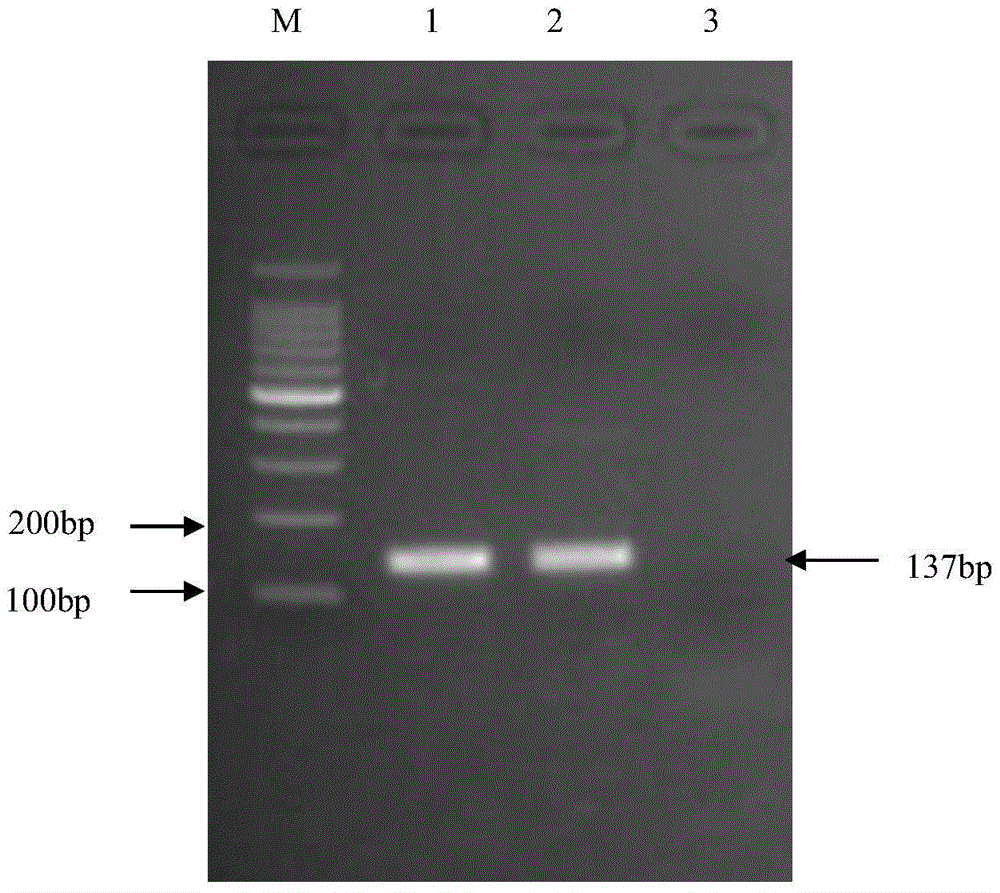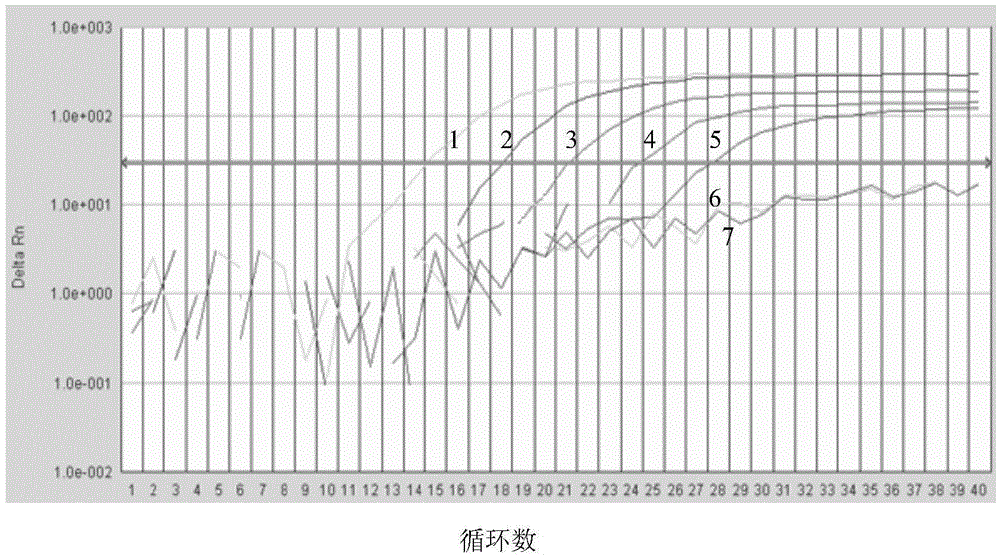Genetic marker of canine parvovirus and specific primers as well as probe thereof
A technology of canine parvovirus and genetic markers, applied in the field of biological detection, can solve the problems of inadaptability to early detection, rapid detection, and difficulty in obtaining fresh red blood cells, and achieve the effects of shortening the detection cycle, good specificity, and increasing the positive rate
- Summary
- Abstract
- Description
- Claims
- Application Information
AI Technical Summary
Problems solved by technology
Method used
Image
Examples
Embodiment 1
[0043] Example 1 Design and synthesis of primers and probes used in canine parvovirus real-time fluorescent quantitative PCR detection method
[0044] According to the canine parvovirus gene sequence published by GenBank, the highly conserved VP2 gene was selected as the amplified region by sequence comparison, and a pair of specific primers and a probe were designed. The primers and probe were synthesized by Bao Biological Engineering (Dalian) Co., Ltd. , PCR amplification product is 137bp.
[0045] The above primer sequences are:
[0046] Upstream primer F: 5'-GCACCATATTATTCTTTTGAG-3' (SEQ ID NO.2),
[0047] Downstream primer R: 5'-CCATGTTGTCTACCAAATG-3' (SEQ ID NO.3).
[0048] The probe sequence is:
[0049] 5'-FAM-ATATCTTGGATCACCATCTGCTGCT-TAMRA-3'
[0050] (SEQ ID NO. 4).
[0051] The amplified target gene sequence is:
[0052] GCACCATATTATTCTTTTGAGGCGTCTACACAAGGGCCATTTAAAACACCTATTGCAGCAGGACGGGGGGGAGCGCAAACAGATGAAAATCAAGCAGCAGATGGTGATCCAAGATATGCATTTGGTAGACAACATGG (S...
Embodiment 2
[0054] Example 2 Establishment of canine parvovirus real-time fluorescent quantitative PCR detection method
[0055] 1. Experimental materials
[0056] 1.1 Virus species, strains and vectors
[0057] Canine parvovirus (CPV2), porcine parvovirus (PPV) and gosling plague virus (GPV) are preserved by our laboratory; DH5α competent cells are preserved by our laboratory; pCR 2.1-T cloning kit was purchased from Invitrogen.
[0058] 1.2 Main instruments and reagents
[0059] The iQ5 fluorescent quantitative PCR instrument was purchased from Bio-Rad; the DNA fragment recovery kit and the fluorescent quantitative PCR2×ExpremixTaq kit were purchased from Bao Biological Engineering (Dalian) Co., Ltd.; the plasmid mini-extraction kit was purchased from Tiangen Biochemical Technology (Beijing) Co., Ltd.
[0060] 1.3 Primers and probes
[0061] See Example 1 for the sequences of the upstream primer F, the downstream primer R and the probe.
[0062] 2. Methods and results
[0063] 2...
Embodiment 3
[0083] Sensitivity, specificity and detection limit evaluation of embodiment 3CPV fluorescent PCR detection system
[0084] 1. Sensitivity evaluation
[0085] Sensitivity, also known as true positive rate, is actually the percentage that is correctly judged as canine parvovirus according to the standard of the detection method of the present invention. The fluorescent quantitative PCR detection system for canine parvovirus established by the present invention and the common PCR method were used to simultaneously detect 120 suspected canine parvovirus clinically isolated disease materials. As shown in Table 1, the sensitivity of the method established by the present invention can reach 98.1% (101 / 103) compared with ordinary PCR (that is, the probe of the present invention is not added, and the primers used are the same as the method of the present invention).
[0086] Table 1 Evaluation of fluorescent quantitative PCR and ordinary PCR detection results
[0087]
[0088] 2....
PUM
 Login to View More
Login to View More Abstract
Description
Claims
Application Information
 Login to View More
Login to View More - Generate Ideas
- Intellectual Property
- Life Sciences
- Materials
- Tech Scout
- Unparalleled Data Quality
- Higher Quality Content
- 60% Fewer Hallucinations
Browse by: Latest US Patents, China's latest patents, Technical Efficacy Thesaurus, Application Domain, Technology Topic, Popular Technical Reports.
© 2025 PatSnap. All rights reserved.Legal|Privacy policy|Modern Slavery Act Transparency Statement|Sitemap|About US| Contact US: help@patsnap.com



